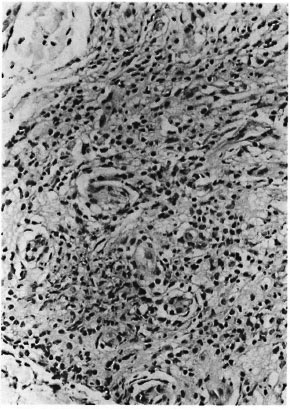- Volume 61 , Number 2
- Page: 292–3
Erythema nodosum leprosum in a case of histoid leprosy
This department is for the publication of informal communications that are of interest because they are informative and stimulating, and for the discussion of controversial matters. The mandate of this Journal is to disseminate information relating to leprosy in particular and also other mycobacterial diseases. Dissident comment or interpretation on published research is of course valid, but personality attacks on individuals would seem unnecessary. Political comments, valid or not, also are unwelcome. They might result in interference with the distribution of the Journal and thus interfere with its prime purpose.
To the Editor:
The occurrence of erythema nodosum leprosum (ENL) is an uncommon phenomenon in patients with histoid leprosy. While some authors postulate that patients with histoid leprosy do not develop the ENL type of reaction (2,7) others have reported the occurrence of ENL in histoid leprosy (1,3-6). We recently saw a patient with histoid leprosy who developed ENL lesions simultaneously.
A 45-year-old male patient presented with diminished sensation over his hands and feet for 15 months and fever, joint pain, testicular pain, and the development of recurrent crops of erythematous tender nodules, subsiding within 3-5 days, over the forearms and shins. Examination revealed a generalized infiltration of the skin with infiltration of the face and earlobes and moderately thickened, extremely tender, bilateral symmetrical ulnar, median and the terminal branches of radial and lateral popliteal nerves. In addition to the nodules arising from infiltrated skin, there were multiple skin-colored, dome-shaped, shiny, firm nodules of 2-5 mm arising from normallooking skin over the lower back on both flanks. He also had bilateral epididymo-orchitis and bilateral palpable, tender, inguinal lymph nodes.
Investigations showed a slit-skin smear result of 5+ 0% from the infiltrated skin and 5+ 1% from the histoid nodules. Acidfast bacilli from the histoid nodules were larger and did not form any globi. A skin biopsy of a histoid nodule showed localized collections of histiocytes, foam cells and lymphomononuclear cells aggregated in the mid- and lower dermis with unremarkable epidermis. Early and late reactions of lepromin were negative. His total leukocyte count was 24,800/cmm; differential count was: polymorphs 71%, lymphocytes 26%, eosinophils 0%, monocytes 3%, T and B lymphocytes were 77% and 23%, CD4+ and CD8 + were 40% and 37%, respectively. The ENL histology was consistent with ENL (The Figure).

The figure. Photomicrograph showing focal leukocytoclastic vasculitis consistent with ENL (H&E x 140).
The patient was started on the World Health Organization multibacillary regimen with dapsone, rifampin and clofazimine along with prednisolone 1 mg/kg/day. Within 48 hr there was symptomatic improvement and the ENL lesions disappeared.
Why patients with histoid leprosy are relatively immune to the ENL reaction is not known exactly, but it is believed to be because histoid leprosy is an immunologically relatively stable form in the multibacillary spectrum of leprosy (6).
- Surrinder Kaur, M.D., F.A.M.S.
Sandipan Dhar, M.D., D.N.B.
Vinod K. Sharma, M.D.
Department of Dermatology, Venereology & Leprology
- Ruma Ray, M.D.
Department of Pathology
Postgraduate Institute of Medical Education & Research
Chandigarh 160012, India
REFERENCES
1. BHUTANI, L. K., BEDI, T. R., MALHOTRA, Y. K., KANDHARI, K. C. and DEO, M. G. Histoid leprosy in north India. Int. J. Lepr. 42(1974)174-181.
2. CHAUDHURY, D. S., CHAUDHURY, M. and ARMAH, K. Histoid variety of lepromatous leprosy. Lepr. Rev. 42(1971)203-207.
3. PRICE, E. W. and FITZHERBERT, H. Histoid lepromatous leprosy. Int. J. Lepr. 34(1966)367-374.
4. RAMANUJAM, K. and RAMU, G. Wade's histoid lepromatous leprosy: report of a clinical study. Lepr. India 41(1969)293-297.
5. RODRIGUEZ, J. N. The histoid leproma, its characteristics and significance. Int. J. Lepr. 37(1969)1-21.
6. SEHGAL, V. N., SRIVASTAVA, G., GAUTAM, R. K. and KORANNE, R. V. ENL in histoid leprosy. Int. J. Lepr. 52(1984)543-544.
7. WADE, H. W. Histoid variety of lepromatous leprosy. Int. J. Lepr. 31(1963)129-142.